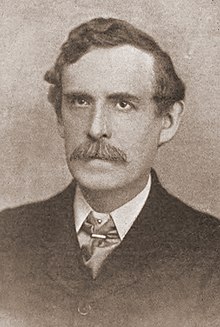Herbert Burrows
Herbert Burrows | |
|---|---|
 | |
| Born | 12 June 1845 Redgrave, Suffolk, England |
| Died | 14 December 1922 Highbury Park, London, England |
| Occupation | Socialist organiser |
| Organization(s) | Manhood Suffrage League; National Secular Society; The Rainbow Circle; Conway Hall Ethical Society; Theosophical Society |
| Political party | Social Democratic Federation |
| Movement | Socialism; trade unionism; secularism; theosophy |
| Spouse | Mary Hannah (m. 1869) |
| Parent |
|
Herbert Burrows (12 June 1845 – 14 December 1922) was a British
Early life
Born in
From 1872, Burrows studied briefly as a non-collegiate student at the
Activism
Burrows moved to London in 1877, where he joined radical clubs including the National Secular Society.[1][2] He was a founder member of the Aristotelian Society in 1880, joined the Social and Political Education League and became Vice President of the Manhood Suffrage League.[1] In 1881, with Henry Hyndman, he formed the Democratic Federation, and became its treasurer in 1883.[1]
Burrows supported the Federation's commitment to socialism in 1884, when it was renamed the Social Democratic Federation (SDF).[1] Often writing under the pseudonym C.V., he contributed articles to its newspaper, Justice.[1] He represented the group on the executive of the Law and Liberty League.[1]
With
Burrows also became a prominent member of
Burrows stood for Parliament unsuccessfully in the 1908 Haggerston by-election,[5] and again in Haggerston in 1910.[1] He resigned from the SDF (then the Social Democratic Party) in 1911.[1]
Death
Afflicted by paralysis from 1917, Burrows died at his home in Highbury Park, London on 14 December 1922.[1]
References
- ^ doi:10.1093/ref:odnb/39607. Retrieved 4 December 2022. (Subscription or UK public library membershiprequired.)
- ^ ISBN 978-0-521-26672-7.
- ISBN 978-0-86193-120-0.
- ^ "Galleries". Conway Hall. Archived from the original on 2 May 2019. Retrieved 7 January 2020.
- ^ "The polling in the Haggerston division of Shoreditch took place..." The Spectator Archive. 8 August 1908. p. 2. Retrieved 2 January 2023.
